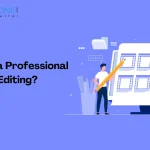People often have a question what is copyediting vs normal editing consists of. Copyediting is the process of reviewing and correcting written material to improve accuracy, clarity, and consistency. It involves checking for and correcting errors in grammar, spelling, punctuation, and syntax, as well as ensuring that the text is clear, concise, and well-organized.
Copyeditors may also review the text for consistency in style and formatting, ensuring that it conforms to the guidelines of the publication or organization for which it is intended. They may also verify that the text is factually accurate and properly cited, and they may check for inappropriate or offensive language.
Read: Why are Literary Devices used? Types of Literary Devices.
Copyediting is typically done by a professional copyeditor or by someone with strong language skills and attention to detail. It is an important step in the editing process, as it helps to ensure that written material is of high quality and free of errors.
It is usually done after a piece of writing has been reviewed and revised by the author, and before it is published or distributed to a wider audience.
You may wonder what is the difference between copyediting and substantive editing then? Are they the same? Do they have to be done together?
Copyediting and substantive editing are two different stages in the editing process. Here is a few listed differences between the two:
Copyediting:
- Focuses on the surface-level details of the text, such as grammar, spelling, punctuation, and formatting.
- Is typically the last step in the editing process, after the writer has completed a draft and before the document is published or distributed.
- Helps improve the accuracy, readability, and consistency of a document.
Substantive editing: - Focuses on the overall structure and content of the text.
- Looks at the big picture and considers how well the document achieves its intended purpose.
- May involve reorganizing the text, adding or deleting information, and making suggestions for improvement.
In summary, copyediting is focused on fine-tuning the details of the text, while substantive editing is concerned with the overall effectiveness and coherence of the document. Both are important steps in the editing process and can help improve the quality of a document.
Here are a few reasons why copyediting is important: Now why is copyediting important though?
It is an important step in the writing process because it helps ensure that the final product is free of errors and is easy to understand.
- Accuracy: Copyediting helps catch mistakes that may have been missed during the initial writing process. This includes spelling errors, grammar mistakes, and factual errors.
- Readability: A well-edited piece of writing is easier to read and understand. Copyeditors can improve the flow and clarity of a document by rearranging sentences and paragraphs, and by suggesting changes to make the writing more concise and straightforward.
- Consistency: Copyediting helps ensure that a document is consistent in terms of style, tone, and formatting. This includes things like using the same spelling for words, using the same font and margins throughout the document, and using appropriate headings and subheadings.
Overall, copyediting is an essential step in the writing process that helps improve the quality and effectiveness of a document.
How can your do copyediting on your own?
Writing and editing are two different worlds and to switch between the two in a hurry would ruin the either of the worlds. So what you need to do is – - Take a break: After you finish writing, it can be helpful to take a break and come back to your work with fresh eyes. This can help you catch mistakes that you might have missed while you were focused on writing.
- Read your work out loud: Reading your work out loud can help you catch errors and awkward phrasing that you might not notice when reading silently.
- Use spelling and grammar check tools: There are several tools available, such as spell checkers and grammar checkers, that can help you catch mistakes and improve your writing. These tools can be especially helpful for catching typos and identifying potential grammar issues.
- Check for consistency: Make sure that your writing is consistent in terms of spelling, punctuation, and formatting. This includes using the same spelling for words, using the same font and margins throughout the document, and using appropriate headings and subheadings.
- Get feedback: Ask a friend or colleague to read your work and provide feedback. This can help you catch mistakes that you might have missed and get a fresh perspective on your writing.
It’s important to be thorough and patient when copyediting your own work. It can be helpful to set aside a dedicated block of time to focus on the editing process, and to take breaks to avoid getting overwhelmed.
You may also like: Guide to Self Publishing on Amazon Kindle Direct Publishing
While copyediting on your own, there are a few things to keep in mind so that you don’t over or under-do it.
DO:
- Check for and correct errors in grammar, spelling, punctuation, and syntax.
- Ensure that the text is clear, concise, and well-organized.
- Review the text for consistency in style and formatting.
- Verify that the text is factually accurate and properly cited.
- Check for inappropriate or offensive language.
- Use a style guide or editorial guidelines to ensure consistency.
DON’T:
- Change the meaning or tone of the text without the author’s approval.
- Add your own personal opinions or interpretations to the text.
- Make wholesale changes to the text without consulting the author.
- Ignore the author’s intended style or voice.
- Make changes that are not supported by the style guide or editorial guidelines.
- Assume that a word is spelled correctly just because it looks familiar.
It is important to approach copyediting with care and attention to detail, while also respecting the author’s intentions and style.
















